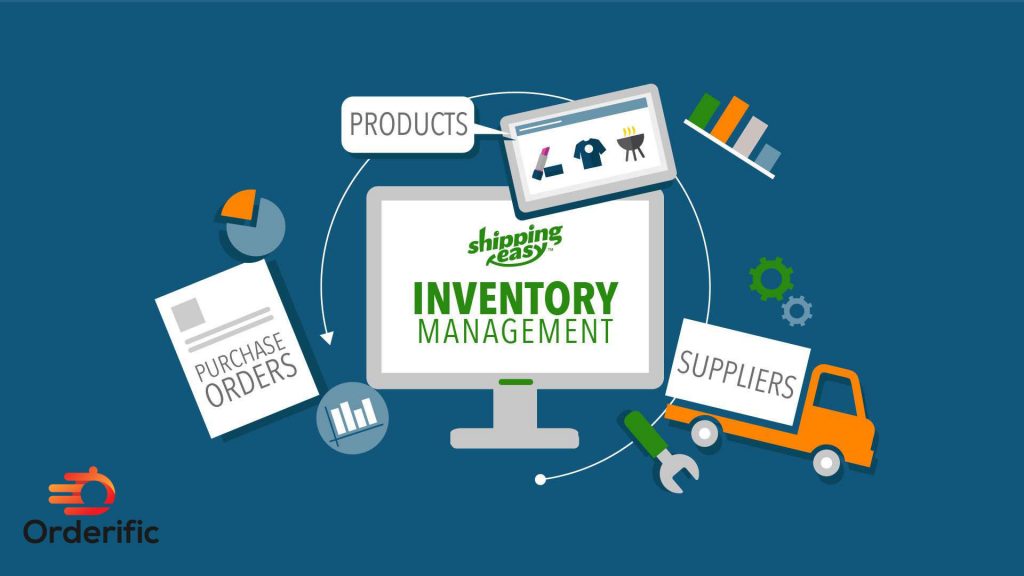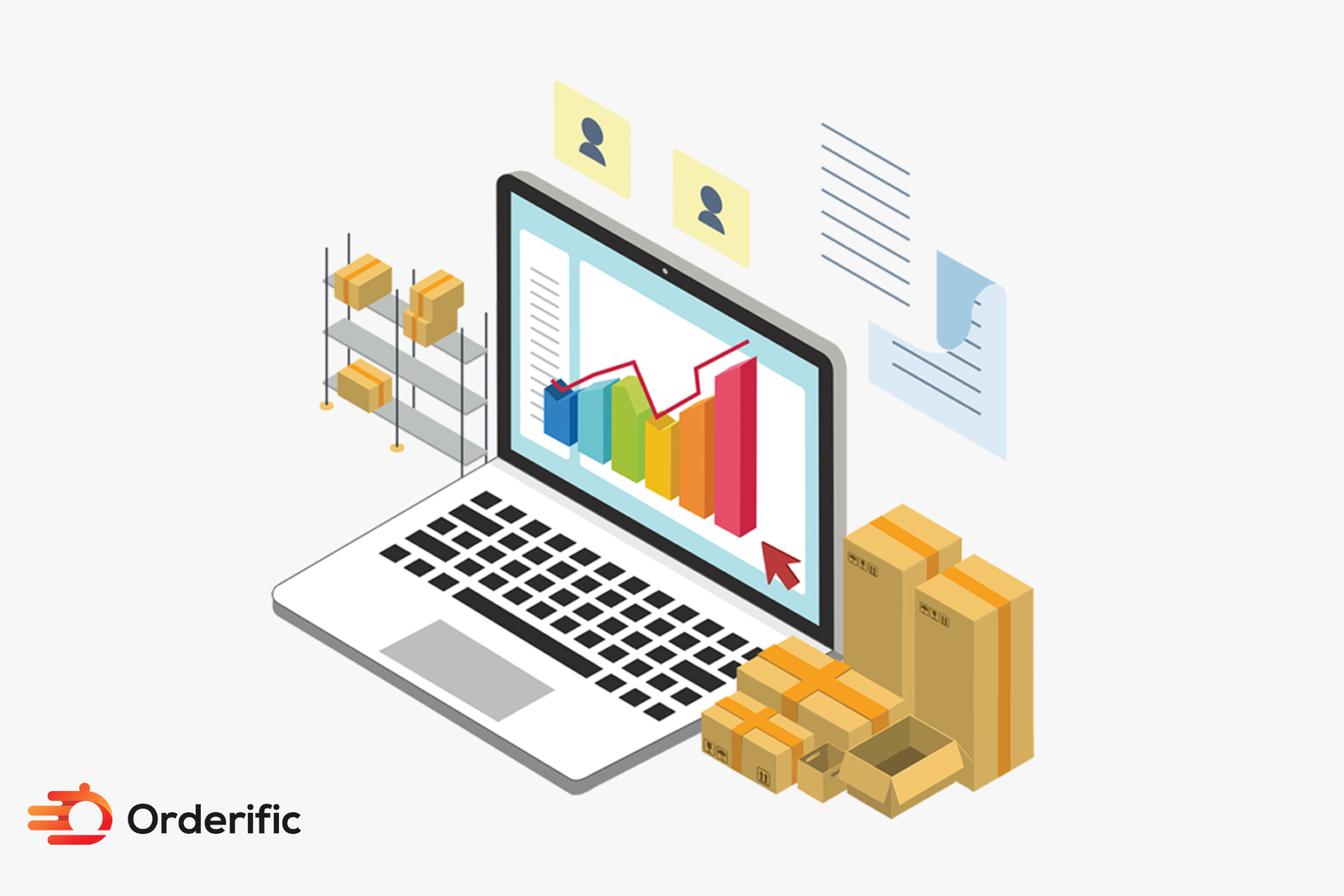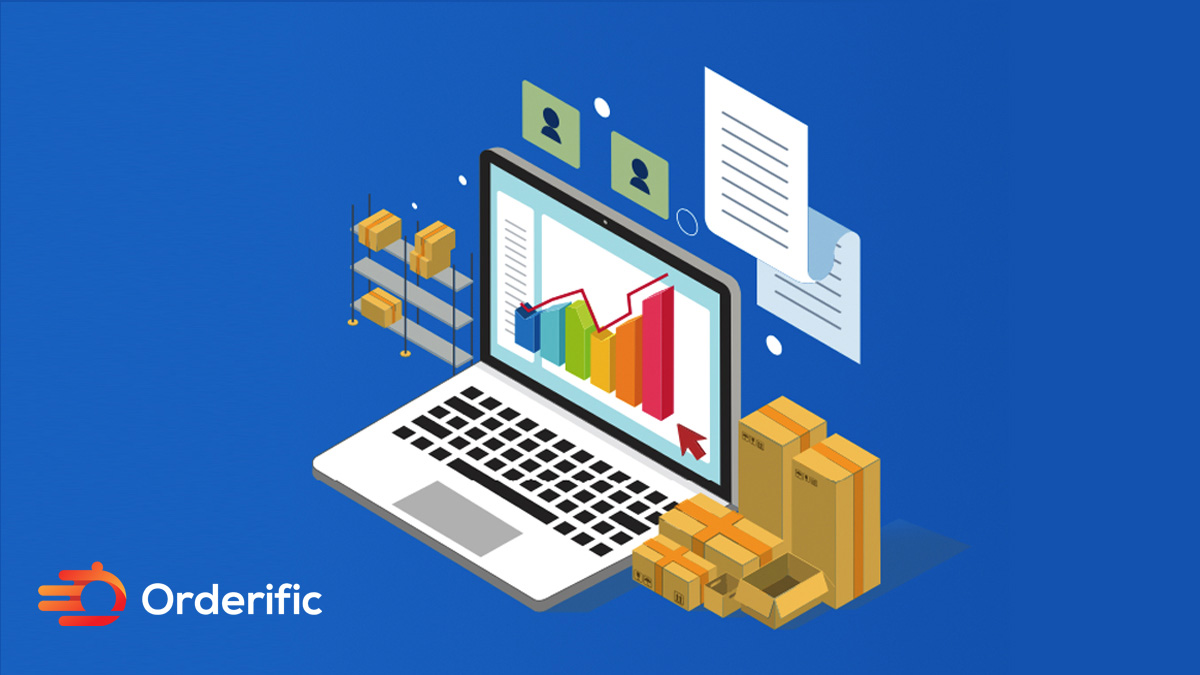In the bustling world of retail, managing your inventory can feel like trying to calm a storm. But what if you could dispel the chaos? With efficient retail inventory management solutions, you can do just that. Visualize your stock levels accurately, easily forecast demand, and keep your cash flow healthy. Imagine the peace of mind knowing that overstock nightmares and stockouts are a thing of the past. Best of all, our tech-savvy tools are designed to reduce the complexity of inventory control, making it a breeze for small businesses and retail giants. It’s Time to boost your profits and let your retail business flourish. With our solutions, you can unlock the full potential of your retail inventory management. Unearth the treasure trove of benefits that await. It’s Time to explore our tools today.
What Is Retail Inventory Management?
Retail inventory management is akin to a well-orchestrated symphony. Picture a grand concert where each musician and instrument plays a distinct role. In this concert, imagine each instrument as a piece of your inventory, each musician as your management software. Imagine their harmonious sounds as the perfect balance of supply and demand in your retail store.
This blend of art and science, known as retail inventory management, is a crucial process in retail operations. It begins with a simple inventory count and a glance at your shelves and warehouses. But then, it transforms into a complex dance of numbers—inventory levels, stock levels, and inventory turnover.
The maestro of this concert, your inventory management software, ensures everything runs smoothly. It maintains a steady rhythm of supply and demand, keeping an eye on customer demand while managing your stock levels. Accurately tracking your inventory minimizes the risk of excess inventory and stockouts.
Yet, it’s not just about the numbers. Retail inventory management is about creating satisfying customer experiences. It’s about ensuring customers find what they need when they walk into your retail store or browse your online sales channel. And ultimately, it’s about leveraging your inventory data to boost your profits and keep your retail business thriving.
In retail inventory management, every note matters, and every beat counts. Like a symphony, it requires precision, coordination, and fine-tuning elements. And with the right tools, you can conduct this symphony with ease. So, come and explore the magic of efficient retail inventory management solutions. It’s Time to make your retail business sing.
How Does Retail Inventory Management Work?
Retail inventory management works much like a busy backstage crew that keeps the grand play of retail running smoothly. It follows a strategic yet flexible approach, maintaining a delicate balance between demand and supply. This miraculous process, so vital to the retail industry, can be broken down into a few key steps:
- Understanding Customer Demand: Picture the pulse of the market, the rhythm of customer demand. This is where retail inventory management begins. It listens to this rhythm, anticipating what customers want and when they want it. Sensing changes in the beat, it adapts swiftly.
- Determining Appropriate Inventory Levels: Imagine the dance of numbers that follows. The management system calculates the perfect inventory levels. It ensures the stage is well-mixed with excess inventory and left barren with stockouts.
- Ordering and Receiving Inventory: Now enters the tactical phase. Purchase orders are made, and inventory is received. Each arrival of finished goods is like a new actor joining the play.
- Inventory Control and Tracking: This is the eye that never sleeps: continuous inventory tracking and control. It keeps a keen watch on stock levels, adjusting the flow as necessary.
- Analyzing Inventory Data: Finally, the grand finale. The system analyzes inventory data, refining strategies for better inventory management. This analysis provides valuable insights, illuminating the path to increased profitability.
Retail inventory management is a ceaseless cycle of planning, executing, and refining. Each step is synchronized with the next, creating a seamless process. It paves the way for efficient management, ensuring every customer finds their desired piece amidst various options. The result? A harmonious retail experience that sings the sweet song of customer satisfaction.
What Is First-In, First-Out (Fifo) In Retail Inventory Management?
First-In, First-Out, fondly known as FIFO, is like a charming dance in retail inventory management. Think of it as a friendly file of products lined up perfectly. The first product to step into this line is the first to exit, graciously making way for new companions.
Imagine your inventory as attendants at a grand ball. Each product, eager to twirl around the retail floor, waits its turn. The products that arrived first get to swirl and dazzle your customers first. Their dance ends as they exit, leaving the floor to newer entrants.
FIFO ensures an orderly, fluid flow in your inventory, creating an elegant harmony between old and new products. It’s like a trusted conductor maintaining the rhythm in your inventory orchestra. Each beat and step is calculated to keep your stock fresh and prevent stagnation.
The beauty of this method lies in its simplicity and effectiveness. It’s all about ensuring that older inventory moves out before the new comes in. This strategy is particularly vital for perishable goods where freshness is king. Yet, it’s equally beneficial for non-perishable goods, preventing them from gathering dust in your warehouse.
FIFO is more than an inventory management technique; it’s an organizational dance. A dance that keeps your cash flow healthy and your customers satisfied. It’s the backstage hero of your retail business, helping you strike the perfect chord of inventory control. With FIFO in your retail inventory management toolkit, you can ensure a smooth, seamless dance of products from the warehouse to the customer’s hands.
What Is Last-In, First-Out (Lifo) In Retail Inventory Management?
Last-In, First-Out, or LIFO, is another intriguing player in the stage play of retail inventory management. Imagine this concept as a bold, lively dance, a thrilling twist to the traditional FIFO waltz. In LIFO, the newest inventory items take center stage first, leaving the older items waiting in the wings.
Picture a bustling backstage, filled with a flurry of products. The latest arrivals, fresh from the suppliers, are eager to dazzle your customers. They leap into the limelight promptly, leaving the older, seasoned items to watch and wait. It’s a unique choreography where the last to enter becomes the first to exit.
The charm of LIFO lies in its novelty and excitement. It’s a bold strategy that thrives on the appeal of the new, feeding the ever-changing customer demand in the retail industry. With LIFO, you ensure your customers can always access your inventory’s latest and greatest items.
But it’s not all about the glitz and glamour. LIFO is also a smart economic move. In periods of rising prices, it can result in lower inventory costs and higher profitability. It’s like a savvy choreographer skillfully maximizing your performance while minimizing your expenses.
LIFO is a thrilling spectacle in the grand ballet of retail inventory management. It infuses a sense of freshness, urgency, and excitement into your inventory. It’s a dance that keeps your retail business vibrant, profitable, and in tune with the rhythm of the market. With LIFO in your repertoire, you can make your retail business the star of the show.
What Is Economic Order Quantity (Eoq) In Retail Inventory Management?
Economic Order Quantity, or EOQ, is the enchanting rhythm that paces the heart of retail inventory management. Imagine it as an astute choreographer, harmonizing the dance of supply and demand. It guides your inventory, calculating the ideal quantity to order, ensuring a perfect equilibrium.
Visualize the elegant dance of numbers. EOQ twirls around ordering costs, carrying costs, and demand rates. It weaves these elements into a formula, creating a seamless performance of efficiency and cost-effectiveness.
You may wonder why EOQ is crucial. Consider it as the unseen string that orchestrates your inventory’s ballet. It balances the act, addressing the risk of stockouts while preventing the burden of overstock. With each calculated move, EOQ helps your business maintain a steady cash flow and healthy inventory levels.
Experience the symphony of your inventory system resonating with the pulse of EOQ. The rhythm manifests in reduced costs, optimized inventory management, and increased customer satisfaction. Watch as your retail store thrives under this harmonious equilibrium, resonating with the rhythm of the market.
EOQ in retail inventory management is more than just a formula. It’s the melodic harmony between inventory costs and demand forecasting. Its rhythm leads to better inventory management, ensuring a seamless dance of products from your warehouse to customers’ hands. Incorporating EOQ in your retail inventory management is akin to setting the perfect tempo for your retail symphony to play.
What Is Just in Time (JIT) In Retail Inventory Management?
Just in Time, or JIT, is like the dramatic finale in the grand opera of retail inventory management. Envision it as a masterful timing expert, orchestrating a perfectly synchronized performance. JIT ensures that products arrive ‘just in time,’ neither too early nor too late. Like a seasoned maestro, this approach ensures harmony, preventing the cacophony of overstock or the silent gaps of stockouts.
Picture the thrill of anticipation that JIT induces — the adrenaline rush of inventory arriving just when it’s needed. Imagine your warehouse as a dynamic stage where products waltz in and out in perfect timing. It’s a captivating spectacle, each product exiting just as the next one enters.
Now, delve deeper into this compelling strategy. JIT isn’t just about perfect timing; it’s also an ingenious cost-saving maneuver. Reducing the time inventory spends in storage minimizes carrying costs. As a result, your warehouse transforms into a streamlined, efficient space, no longer burdened with excess stock.
At the heart of JIT lies a keen understanding of customer demand. By accurately predicting when customers will need a product, JIT ensures your shelves are always stocked aptly. This precise orchestration leads to delighted customers, their desired products always within reach.
Embracing JIT in retail inventory management isn’t just a strategic decision; it’s a transformative journey. It infuses your retail operations with rhythm, precision, and efficiency. Implementing JIT is like conducting a grand symphony, each note — each product — hitting the perfect beat, resonating with your customers’ desires.

Best Practices for Becoming an Expert in Retail Inventory Management
Mastering retail inventory management is akin to becoming a virtuoso in an orchestra, finely tuning your instruments and coordinating every melody. It requires a blend of strategy, precision, and adaptability. With the right practices, you can transform your retail business into a symphony of efficiency, profitability, and customer satisfaction. Read on to discover the best practices that can turn you into a maestro of retail inventory management.
Analyze Data
Your journey to becoming a maestro in retail inventory management begins with embracing data. Picture data as a gold mine brimming with precious insights. You delve into this mine, unearthing nuggets of valuable information. Each nugget, each data point, holds the potential to make your retail symphony more harmonious.
You begin by scrutinizing sales data. This involves tracking your best-selling items, identifying trends, and detecting changes in demand. It’s like listening to the rhythm of your customers’ preferences and adjusting your inventory orchestra accordingly.
Next, you turn to your supply chain data. Imagine it as the backstage crew of your retail performance. It keeps the show running smoothly, ensuring timely deliveries and managing supplier relations. Analyzing this data provides the spotlight that always shines brightly on your store’s inventory.
Your voyage into data continues. You also explore inventory turnover rates and carrying costs. This analysis is akin to fine-tuning your retail symphony, optimizing inventory levels, and ensuring cost-effectiveness.
Data analysis in retail inventory management is a thrilling exploration. It’s the compass guiding your decisions, the sheet music to your retail symphony. By embracing data, you set the stage for a dazzling performance that delights your audience and keeps the cash registers ringing.
Implement Software
Imagine stepping into a world where technology harmonizes your retail symphony. This world is brought to life with retail inventory management software. It acts as the conductor, coordinating each movement and ensuring your orchestra plays in unison.
The software transforms your inventory data into a beautiful visual display. With it, you can track your inventory with the grace of a seasoned maestro. You know each product’s volume, location, and status, akin to knowing every note in a melody.
Transitions become seamless. Stock levels are updated in real-time, mirroring your sales. It’s like listening to a live symphony, every beat resonating instantly.
This tool isn’t just a technological marvel; it’s a game-changer. It streamlines your operations, transforming your retail experience into a harmonious performance. The result? A retail orchestra that hits the perfect chord with customers every Time.
In summary, implementing software in retail inventory management is like composing a masterpiece. Its rhythm resonates with efficiency, accuracy, and customer satisfaction. It’s your ticket to conducting a stellar retail symphony rich with the melody of success.
Prioritize Products
In your retail symphony, every product plays a unique note. Prioritizing these products is akin to mastering the melody and understanding each note’s significance. Visualize your inventory as a grand orchestra, each product contributing its unique sound.
Some items might be the showstoppers, the lead artists that command attention. These are your high-selling items, the rhythm that your customers love. Then, there are the supporting artists that beautifully complement the lead. These items may not fly off the shelves but add substance to your store’s symphony.
Prioritizing products in retail inventory management is like arranging the music sheets. It’s about knowing which notes to highlight and which ones to harmonize. It’s about ensuring your retail orchestra plays a melody that resonates beautifully with your audience.
Hence, delve into your sales data and understand the rhythm of your customers’ preferences. Give center stage to the products that sell the most, but pay attention to the charm of the less popular ones. Each product has its role; each item adds a unique note to your retail symphony. Prioritizing products allows you to conduct this symphony, creating a retail experience that’s music to your customers’ ears.
Investigate the Bottom Line
Dive deep into your retail symphony’s financial performance. Envision it as the orchestra’s tempo, guiding your business rhythms. Start by analyzing your gross profits, akin to listening to the melody of your revenue. Next, consider the rhythm of your operational costs, resonating with the beats of your expenses.
Pay attention to inventory carrying costs. These costs, like a persistent drumbeat, can erode your profits steadily. Imagine them as the low notes in your symphony, often overlooked but significantly impactful.
Then, tune into your sales. Listen to the high notes of your profits and the applause your business garners. Combine it with the low notes of costs, creating a harmony that reverberates with financial health.
Transition to your net profits, the crescendo of your business performance. The symphony’s climax is the result of all your strategic efforts. Investigating the bottom line in retail inventory management is like a thrilling finale. It’s your grand applause, your cue for a standing ovation.
In summary, this process is like conducting a financial audit of your retail symphony. Investigating the bottom line ensures your retail business resonates with financial success. Let your symphony sing the melody of profitability and growth.
Demand Planning
Demand planning in retail inventory management is like the conductor’s baton, guiding the symphony’s tempo. It starts with understanding your audience – the customers. Imagine them as a captivated audience, their applause your cue for success.
Next, take a deep dive into past sales data. Visualize it as the sheet music, its rhythm hinting at future demand. Delve into this rhythm, learning from it, adapting to its tune. Authentically, it inspires your retail symphony’s future performance.
Following this, factor in market trends. Picture them as the changing melodies, their beats influencing your symphony. Their resonance drives the conductor’s baton, steering your inventory strategy.
Finally, align your supply chain. Envision it as the harmony to your melody; its smooth functioning ensures a flawless performance. Properly tuned, it provides your retail symphony that resonates with the rhythm of customer demand.
Balancing these elements, demand planning crafts the ideal inventory levels. It’s akin to composing the perfect symphony – each note, each product hitting just the right beat.
In conclusion, demand planning isn’t just a practice. It’s the art of conducting a masterful retail symphony. Its rhythm resonates with precision, profitability, and customer satisfaction. Embrace it, and let your retail business hum the melody of success.
Audit Inventory Movements
Auditing inventory movements in retail inventory management is akin to a dress rehearsal for your retail symphony. It’s a meticulous process akin to fine-tuning each instrument before the grand performance.
Imagine each product as a performer, the stage being your warehouse. As each product enters the stage, it adds a note to your symphony. And each exit, a pause, forms a rhythm, a melody of movement.
First, focus on your inbound inventory. Consider it the opening act. Each product’s entry is like the first swell of music, setting the tone for your retail performance.
Next, examine your on-hand stock. Envision it as your orchestra’s core, playing the symphony’s steady rhythm. The right amount creates a harmonious melody, striking the perfect balance.
Lastly, scrutinize your outbound stock. Visualize this as the grand finale of your symphony, each product finding its way to the customer.
Conducted meticulously, an inventory movement audit ensures harmony in your retail symphony. It helps prevent discordant notes of stockouts and overstocks, guaranteeing a seamless performance.
In conclusion, auditing inventory movements is a rhythmic exploration, a backstage peek into your retail symphony. Embrace it to craft a retail performance that resonates with efficiency, cost-effectiveness, and customer satisfaction.
Data Mining
In the grand symphony of retail inventory management, data mining is like discovering a hidden melody. Picture it as an exciting treasure hunt, each clue leading to a deeper understanding of your business. As you delve into the depths of data, you unearth sparkling insights akin to finding precious gems.
Every nugget of information adds a unique note to your retail symphony. Each piece of data, like a musical chord, harmonizes with your strategy, guiding your decision-making process. It’s the rich tapestry of information that whispers your customers’ secret desires, helping you tune your business to their rhythm.
Ultimately, data mining in retail inventory management is akin to a maestro deciphering a complex musical score. It’s an art, and when done right, it can transform your retail business into a masterpiece that resonates with success. Each note, each data point, harmonizes to create a melody of efficiency, profitability, and customer satisfaction. Immerse yourself in this fascinating exploration, and let your retail symphony serenade your audience with the sweet music of success.
Scheduling
Scheduling in retail inventory management is like the metronome ticking away, guiding the rhythm of your retail symphony. Picture it as the gentle sway of the conductor’s baton, orchestrating the ebb and flow of your inventory.
Like a vibrant note, each product gets its perfect timing, appearing on stage precisely when needed. Your sales data, customer trends, and market insights are the tickets to this captivating performance.
These elements blend beautifully, setting a rhythm that matches your customers’ beat. Your inventory flows smoothly, like an enchanting melody, capturing the audience’s attention.
Behind the scenes, the spectacle is just as breathtaking. Your warehouse buzzes harmoniously as products make their timely entrances and exits.
Ultimately, scheduling in retail inventory management is akin to conducting a tightly timed symphony. The result? A performance that resonates with precision, profitability, and customer satisfaction. Embrace the rhythm of scheduling, and let your retail symphony play the sweet melody of success.
Separate Your Inventories
In the grand scheme of retail inventory management, consider separating your inventories as the different sections of your symphony orchestra. Each section – strings, brass, woodwinds, and percussion – plays its unique part, contributing distinct sounds to the overall melody. Similarly, separating your inventories allows each category to shine in its own right, whether it’s top-selling items, seasonal goods, or promotional products.
Just as a conductor knows the importance of each instrument and how it correlates within the orchestra, so should you understand the role of each inventory category. This process helps to ensure the right products are available in the right quantities at the right Time.
Separating your inventories is akin to the maestro meticulously arranging the symphony’s sections. It’s a deliberate strategy that breathes life into your retail symphony, transforming it into a harmonious and resonating performance.
Separating your inventories is an integral part of retail inventory management. The symphony’s harmony and rhythm keep your performance on track, ensuring a music retail experience for your customer’s ears. Embrace this strategy and let your retail symphony serenade customers with the melody of success.
Use Data From Sales Channels for Better Predictions
Using data from sales channels in retail inventory management is akin to the maestro studying past performances to perfect the upcoming symphony. Picture it as a journey back in Time, sifting through old sheet music, each note whispering invaluable insights. Just as the maestro learns from past performances, you, too, can use sales data to refine your inventory strategy.
Imagine each data point as a musical note, its rhythm hinting at future demand. As the maestro of your retail symphony, you blend these distinct notes into a beautiful melody that anticipates customer demand accurately. Like a resounding applause, each sale is a testament to your inventory strategy’s success.
This process, over time, fine-tunes your inventory management, striking the perfect chord with your customers. Ultimately, using data from sales channels isn’t just good business practice; it’s an art. The rhythm breathes life into your retail symphony, ensuring a performance that resonates with efficiency, accuracy, and customer satisfaction.
Let your retail symphony flourish under the guidance of sales data. Embrace this strategy, and let your retail business hum the melody of success.
Embrace Technology
Embracing technology in retail inventory management is akin to the maestro incorporating modern instruments into a classical symphony. Imagine it as introducing a synthesizer into your orchestra, infusing your performance with a unique twist. As the synthesizer harmonizes with traditional instruments, modern technology seamlessly integrates with your retail operations. Like a fresh melody, this digital transformation brings efficiency, accuracy, and speed to your inventory management.
Picture your warehouse as the grand stage, now equipped with cutting-edge technology like AI, machine learning, and cloud computing. Like a vibrant laser show accompanying a symphony, these technologies illuminate every corner of your operations. They streamline your processes, automate repetitive tasks, and accurately predict future demand.
Now, shift your focus to the audience – your customers. In this digital era, they expect a seamless shopping experience akin to a flawless symphony. As you embrace technology, you can meet these expectations consistently, ensuring every note hits the right chord with your customers.
In summary, embracing technology is a strategic move in retail inventory management. It’s the maestro’s modern touch to a traditional symphony, creating a melody that resonates with efficiency, profitability, and customer satisfaction. So, let your retail symphony embrace the rhythm of technology and serenade your audience with the sweet music of success.
Jit Inventory Management
Just-In-Time (JIT) inventory management in the retail sector is the hidden conductor behind the curtain of your retail symphony. Picture it as the unseen force, like an invisible metronome, guiding the tempo of your inventory flow. Each beat brings forth the precise product that the market demands, much like a well-timed note in a symphony.
With JIT, imagine your inventory as an ensemble of musicians, each ready to perform on cue. The stock levels are perfectly synchronized, mirroring the rhythm of customer demand. Consequently, the risk of overstocking and understocking, like discordant notes, is significantly diminished.
The JIT strategy, akin to a masterful conductor, keeps the warehouse clear and organized. It is like a well-practiced orchestra, with no instrument playing out of turn. This efficiency evokes a harmonious melody, a rhythm that resonates with profitability and customer satisfaction.
JIT inventory management isn’t just a strategy. It’s the symphony’s unseen conductor; it’s the rhythm that crafts a seamless retail performance. Embrace JIT, and let your retail symphony play the perfect melody of success.
Partnerships
In the grand orchestra of retail inventory management, partnerships are the handshake agreements between the conductor and the musicians. Envision these collaborations as the heartfelt conversations before the symphony, filled with anticipation and excitement. Strong partnerships streamline your inventory operations as the maestro and musicians unite for a melodious performance.
Imagine each partner as a skilled musician, their expertise contributing to your retail symphony. When well-coordinated, these partnerships strike the right chord, ensuring a harmonious melody of efficiency and profitability. Remember, a finely-tuned partnership, much like a well-practiced duet, can elevate your performance.
Now, consider the audience – your customers. They appreciate the harmony, the seamless retail experience, much like a flawlessly executed symphony. Thus, successful partnerships form the underlying rhythm, creating a customer experience that’s music to their ears.
Forging strong partnerships is a strategic move in retail inventory management. It’s the conductor’s bond with the musicians, a relationship that resonates with efficiency, profitability, and customer satisfaction. So, let your retail symphony flourish with solid partnerships and serenade your audience with the sweet music of success.
Staff Training
Staff training in retail inventory management is like the dedicated rehearsals before a grand symphony. It sets the stage for a flawless performance, much like diligent practice fine-tunes a musical piece. Like musicians, staff members need to understand the rhythm of inventory flow. They must know their roles and how their actions contribute to harmony.
Imagine each training session as a rehearsal, where every staff member fine-tunes their skills. These sessions equip your staff with the knowledge and tools to play their part in the retail symphony. As your staff becomes more adept, every movement in the warehouse begins to mirror the rhythm of a well-practiced orchestra.
Consider your customers as your audience, eager for an enchanting performance. With well-trained staff, like skilled musicians, you can deliver a retail experience that is music to their ears. Your customers appreciate the flawless performance, enhancing their loyalty to your retail brand.
Staff training isn’t simply a process; it’s a vital part of your retail symphony. It’s the rhythm, the harmony, the secret to a perfect performance. So, invest in staff training and let your retail symphony hit the high notes of success.
Perform Regular Stock Takes
Regular stock takes in retail inventory management are like the intermissions in a grand symphony. Imagine them as brief moments of stillness, where the orchestra pauses, allowing the maestro to assess the performance thus far. Just as the intermission allows for a quick tune-up or re-orchestration, regular stock takes provide opportunities to realign your inventory strategy.
Consider each stock take as a careful review of the sheet music, each product representing a unique note. Much like a pause in the melody, this process allows for a comprehensive evaluation of your inventory. It’s a chance to spot discrepancies, like a discordant note, and rectify them promptly.
Furthermore, regular stock infuses a rhythm of precision into your retail symphony. They ensure accuracy and prevent stock inconsistencies, much like a well-rehearsed ensemble maintains harmony. This rhythm resonates with efficiency and profitability, creating a retail melody that captures your audience’s customers’ attention.
Performing regular stock takes is a fundamental strategy in retail inventory management. It’s akin to the intermissions in a symphony, a pause that fine-tunes the performance. So, embrace the rhythm of regular stock takes, and let your retail symphony serenade your customers with the sweet music of success.

Harnessing the Power of Forecasting in Retail Inventory Management
Forecasting, in the context of retail inventory management, is akin to the maestro surveying the audience before the symphony begins. Carefully, he gauges their number, their moods, and their expectations. He takes note of the chatter, the rustle of programs, the hushed anticipation. All these insights come together, helping him perfectly tailor the night’s performance to the crowd. Much the same, forecasting allows you to understand future customer demand, ensuring a finely tuned inventory that resonates with their needs.
Imagine your retail inventory as the symphony’s sheet music, each product a note. As the conductor of this retail symphony, you use forecasting to construct the perfect melody. You must anticipate the demand tune in advance to ensure an enchanting performance. The forecasting tools, like the maestro’s baton, guide your decisions, shaping your inventory strategy.
Consider how the maestro relies on past performance reviews, crowd reactions, and musician feedback. This is akin to the data you use to formulate your forecasting model. Indeed, the rhythm of past sales, the melody of market trends, and the harmony of seasonal fluctuations all contribute to your predictive analysis.
Finally, envision the moment when the maestro, satisfied with his forecast, raises his baton, and the orchestra begins to play. Similarly, with accurate forecasting, your retail inventory management hits the right notes. In the end, harnessing the power of forecasting isn’t merely a strategy; it’s an art. The rhythm breathes life into your retail symphony, promising a performance that resonates with accuracy, efficiency, and customer satisfaction. So, let your retail symphony sing the sweet melody of success with the power of forecasting.
Embracing the Symphony of Cross-Docking
Cross-docking in retail inventory management can be likened to a harmonious interplay between different sections of a grand symphony. Picture it as a rhythmic exchange, where each piece of merchandise dances seamlessly from the supplier truck to the outgoing transport, perfectly timed like a passing note in a symphony. Much like a symphony’s harmony, this strategy ensures inventory fluidity and reduces the need for storage.
Imagine the dock as the orchestra’s stage, the incoming and outgoing trucks as the symphony’s sections. Just as the conductor coordinates the musicians for a flawless performance, the inventory manager ensures a seamless transition of goods, striking the right chord with efficiency and speed. In a flash, the merchandise, like a swiftly passed baton, moves without missing a beat.
Consider the role of technology in this process, akin to a metronome guiding the orchestra’s rhythm. With advanced tracking systems, like an attentive conductor, you can oversee the entire cross-docking process. It’s a dance of merchandise orchestrated with precision, mirroring the rhythm of a well-coordinated symphony.
Cross-docking isn’t just a strategy; it’s an art form. The rhythm breathes life into your retail symphony, ensuring a performance that resonates with efficiency, speed, and customer satisfaction. So, let your retail symphony hum the melody of success with the power of cross-docking.
The Melody of Vendor-Managed Inventory in Retail
Vendor-managed inventory (VMI) in retail inventory management is akin to the chorus in a grand musical composition. Picture it as a harmonious collaboration, where the vendor, like a well-tuned choir, replenishes your inventory at the right Time. Much like a chorus’s melody, this strategy ensures balance and continuity in your retail symphony.
Consider your vendor as the choir director, guiding the rhythm of your inventory flow. Just as the director ensures each voice contributes to the melodic harmony, your vendor fine-tunes your stock levels. Like a well-sung chorus, this process resonates with the rhythm of efficiency and profitability.
Imagine the synchronization of this process, evoking the harmony of a choir in perfect unison. With well-managed inventory, you can create a retail experience that is music to your customer’s ears. Just like a chorus adds depth to a symphony, VMI contributes to a seamless and balanced retail symphony.
Picture the mutual trust in this partnership, much like the bond between the choir and the director. Like a finely tuned chorus, this collaboration provides the rhythm of success in retail inventory management.
VMI isn’t merely a strategy; it’s the melody of your retail symphony. The rhythm breathes life into your performance, promising a chorus that resonates with harmony, efficiency, and customer satisfaction. So, let your retail symphony sing the sweet melody of success with the power of vendor-managed inventory.
The Rhythm of Multi-Echelon Inventory Optimization
Multi-echelon inventory Optimization in retail inventory management is akin to the complex symphony of an orchestra. Picture it as an exquisite ballet of precision and coordination. Each layer of your supply chain, like a section of the orchestra, plays its unique part. Together, they create a rhythm that resonates with efficiency and profitability.
Take a moment to imagine your supply chain as the ensemble, each echelon a talented musician. Just as each instrument contributes to the symphony’s rhythm, every echelon of your inventory plays its pivotal role. The result? A retail symphony that ebbs and flows with a mesmerizing fluidity.
Let your mind wander to the conductor, the maestro who orchestrates the entire performance. This is your inventory manager, adeptly coordinating the multiple echelons. Like a maestro leading the orchestra, the manager guides the rhythm of your retail performance.
Moreover, consider the role of technology in this process. It’s akin to the score that guides the orchestra, providing the rhythm and sequence for the performance. Similarly, advanced forecasting tools shape your multi-echelon strategy, striking the perfect note efficiently and accurately.
Lastly, envision your audience – your customers. They revel in the harmony of your retail performance, appreciating the smooth flow of your inventory. Indeed, just as an orchestra impresses its audience with its symphony, your retail business captivates customers with its seamless operations.
Multi-echelon optimization isn’t merely a strategy; it’s a harmonious symphony in your retail performance. It ensures your retail operations resonate with efficiency, speed, and customer satisfaction. So, let your retail symphony hum the melody of success with the power of multi-echelon inventory optimization.
Leveraging the Harmony of Dropshipping in Retail Symphony
In the grand symphony of retail inventory management, dropshipping is akin to the resonant harmony produced by a well-tuned orchestra. Picture it as a continuous melody, where the supplier, much like a master violinist, perfectly synchronizes with your retail operations. This strategy, like the captivating harmony of an orchestra, seamlessly integrates supplier responsibilities, reducing your inventory overhead.
Just as the violinist entrusts the composition’s rhythm to the conductor, you, as a retailer, rely on the supplier to fulfill customer orders. Imagine the fluid exchange, akin to the smooth melody transfer from one instrument to another. Like a captivating harmony, this process resonates with efficiency, reducing warehouse space and managing costs effectively.
Consider the role of technology, much like the sheet music guiding the musicians. With advanced e-commerce platforms, you can oversee the entire dropshipping process. It orchestrates orders, mirroring the harmony of a well-rehearsed symphony.
Now, envision your customers, the privileged audience of your retail symphony. They appreciate the seamless experience, enhancing their loyalty to your retail brand. Indeed, as an orchestra creates a harmonious symphony, dropshipping contributes to a smooth and efficient retail process.
Dropshipping is not merely a strategy; it’s a harmonious note in your retail symphony. The rhythm breathes life into your performance, promising a melody that resonates with efficiency, speed, and customer satisfaction. So, let your retail symphony play the sweet harmony of success with the power of dropshipping.
The Cadence of Just-in-Time Inventory in Retail
Just-in-Time (JIT) inventory in retail inventory management is much like the cadence in a symphony, a rhythm that guides the entire performance. Picture it as the heartbeat of your retail operations, each pulse resonating with efficiency and profitability.
Imagine your inventory as the musicians in an orchestra, their performance guided by the steady rhythm of the JIT method. Just as each note is played at the perfect moment, your products arrive precisely when needed. Like the cadence in an enthralling symphony, this rhythm ensures a seamless inventory flow, reducing overstocks and eliminating stockouts.
Now, consider the role of your supplier, akin to the drummer setting the beat. With JIT, they replenish your inventory on cue, striking a balance between demand and supply. This process, like the rhythmic pulse of a drum, resonates with efficiency, reducing storage costs and improving cash flow.
Think about the role of technology in this strategy, similar to the metronome guiding the musicians’ pace. Advanced forecasting tools and real-time analytics keep your inventory in tempo with customer demand, ensuring a harmonious retail performance.
Finally, envision your customers, the captivated audience of your retail symphony. They appreciate the smooth, efficient service as a result of your JIT strategy. Indeed, just as a symphony enchants its listeners with its rhythmic cadence, JIT inventory management captivates customers with its seamless operations.
JIT inventory isn’t just a strategy; it’s the rhythmic heartbeat of your retail symphony. It ensures your retail operations resonate with efficiency, speed, and customer satisfaction. So, let your retail symphony play the captivating cadence of success with the power of Just-in-Time inventory.
Synchronizing Retail Operations with Centralized Inventory Management
Centralized inventory management in the symphony of retail operations is akin to the conductor’s masterful synchronization. Imagine it as a rhythmic coordination, each instrument, your inventory, harmonizing perfectly in real-time. Like the conductor’s precise direction, this strategy ensures a seamless performance, enhancing your retail orchestra’s efficiency and profitability.
Picture your inventory spread across different channels, akin to a grand orchestra’s sections. Just as the conductor synchronizes each musician for a harmonious performance, centralized inventory management brings together each channel. It ensures perfect timing, resonating strongly with efficiency and accuracy.
Now, consider the role of technology, similar to the score guiding the conductor. Advanced inventory management systems serve as your comprehensive guide, maintaining harmony among all channels. It’s a symphony of data, echoing the precision of a well-coordinated orchestra.
Envision your customers, the enchanted audience of your retail symphony. They revel in the seamless experience, the result of your centralized strategy. Just as an orchestra’s harmony captivates its audience, centralized inventory management impresses customers with its smooth operations.
Finally, imagine the peace of mind this strategy provides. Much like an orchestra’s confidence in its conductor, you trust your centralized system to keep the rhythm of retail operations. The harmony breathes life into your retail symphony, ensuring a performance that resonates with efficiency, speed, and customer satisfaction.
Centralized inventory management isn’t merely a strategy; the synchronization key orchestrates your retail symphony. So, let your retail symphony play the captivating rhythm of success with the power of centralized inventory management.
Perfecting Retail Melody with Perpetual Inventory System
The Perpetual Inventory System, in the grand orchestra of retail inventory management, is like the perfect melody that delights every listener’s ear. Picture it as the soothing rhythm that breathes life into your retail operations. Much like a flawless melody, this technique ensures a seamless inventory flow and real-time tracking.
Now, let your mind wander to the role of technology in this process. It’s much like the musical notes that guide a musician, shaping the melody. With advanced software systems, you can strike the perfect chord, achieving balance and precision in your inventory management.
Imagine a captivating performance that unfolds moment by moment. Just as a melody unfolds note by note, your inventory updates take shape in real-time. This continuous flow, rhythmic and harmonious, resonates with efficiency and profitability.
Consider your customers akin to an entranced audience, reveling in the melody of your retail operations. Like a standing ovation, their satisfaction is the reward for your seamless and efficient service.
Lastly, think of the peace of mind a perpetual inventory system brings. It’s like the confidence a musician feels when playing a well-rehearsed melody. Trust in your system to keep the rhythm of your retail operations, ensuring a performance that resonates with efficiency, speed, and customer satisfaction.
The Perpetual Inventory System is not merely a strategy; it’s the heart of your retail symphony. The rhythm breathes life into your performance, promising a melody that resonates with efficiency and customer satisfaction. So, let your retail symphony play the sweet melody of success with the power of a Perpetual Inventory System.
Conclusion
In conclusion, the melody of effective retail inventory management resounds with harmony and precision, guiding each note of your retail operations to success. Through strategies like Vendor Managed Inventory, Multi-Echelon Optimization, Dropshipping, Just-In-Time, Centralized Management, and a Perpetual System, the symphony of your inventory management becomes a tantalizing performance, resonating with both efficiency and customer satisfaction. This is the rhythm of success in retail, a pleasing melody that attracts and retains a loyal audience – your customers. Now, isn’t it Time for your retail symphony to play its captivating melody of success?
Explore Orderific for a seamless integration of these strategies. Our solution is designed to increase revenue while decreasing operational costs, offering you more control and providing a better user experience. With Orderific, you can focus on fine-tuning your retail symphony while we automate manual tasks like order and payment processing. Schedule a FREE DEMO today to learn how Orderific can orchestrate your inventory management.
FAQs
How do retailers manage their inventory?
Retailers manage their inventory using strategies like drop shipping, JIT inventory, and centralized and perpetual inventory systems aided by advanced technology.
What are the five types of inventory management?
The five types of inventory management are Just-in-Time, Dropshipping, Centralized, Perpetual, and Multi-Echelon systems.
What are the basic steps in retail inventory management?
The basic steps in retail inventory management are forecasting, tracking, controlling stock, and regular auditing.
What is the retail inventory management method?
Retail inventory management involves managing stock levels to ensure efficient fulfillment while minimizing costs.













